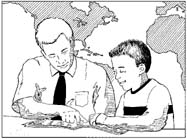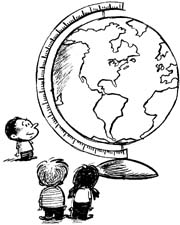

The Extent of the Problem
Cultural Diversity is a extensive topic.
As described by the American
Psychiatric Association it includes issues of race, sex, language,
age, country of origin, sexual orientation, religious/spiritual beliefs,
social class and physical disabilities. Even though is so vast we will
emphasize our work in the issues related to ethnicity.
One of the factors to consider
when talking about ethnicity is the rapid growth in diversity within the
population composition. More than one third of the population is non-white.
The most rapid growth would be in Latinos and Asian. Just the latinos had
increased by 69% from the 1970 to the 1990’s. The rates of birth will promote
that unceasing growth.
Another factor to contemplate would be the
effect of this diversity and it's rapid growth. One of these would be the
tension that exist among different racial and ethnic groups. The potential
for racial conflict always exists in our multicultural society and periodically
there are widespread and serious racial incidents.
In addition we have to reflect about the repercussions
on education. The number of students in United States with limited English
proficiency go beyond 2.3 millions (1992). These are students whose cultural
and educational backgrounds might not correspond to the norms and expectations
they will encounter in school. This will promote conflicts that can affect
academic achievement as well as relationships. Violence in school are matter
of significant public concern, particularly after the wave of tragic school
shootings in recent years, and the increasing number of incidents of aggressive
and violent actions in schools. Consequently principals have expressed
the need for successful strategies to dispel racial tensions, class conflict
and violence (specially related to race or ethnicity). Furthermore it strive
for the dissemination of new research in this growing academic field, and
in counseling as well.

Behavioral Characteristics
Ethnic conflict as defined by Neil Funk-Unrau refers to conflicts which
move out of the realm of interaction between sovereign states and focus
more on the interaction of culturally defined sub state units. In other
words it will be conflicts between sub-groups or small groups beneath a
big group. In this case conflicts between different ethnic groups (race,
language or place of origin). From this perspective, conflict between such
units is a normal consequence of the different perceptions, mindsets and
value systems held by them.
Ethnic and cultural conflict will be
manifested in different observable behaviors. For instance physical fights,
racial slurs, calling names, graffiti, gangs activities, school shootings
among others. On the other hand there are attitudes below the surface that
are not that evident such as racial hatreds, avoiding certain groups, excluding
certain groups, perceptions that treatment is unequal across groups, competition
for resources and attention, power and status struggles among racial groups.
Even deeper, mind sets of segregation, racism, socialization, inequality,
discrimination, stereotypes, prejudice, and ethnocentrism (the belief
that one’s own group is superior).

Counseling Strategies:
Conflict Resolution through Peer
Mediation
Ethnic conflict is a major concern in
our schools. It has many adverse repercussions: Bulling, racial slurs,
and violence etc. However, by working together, guidance counselors, teachers
and students, can put an end to racial strife. One strategy that
schools have found to be successful in resolving racial conflicts is by
implementing a program called Conflict Resolution through peer mediation.
Peer mediation has become one of the most widely used techniques in conflict
resolution procedures.
Mediators
are required to complete basic training of a minimum of 12 to 15 hours,
followed by another 12 to 15 hours of advanced training. (Donahue, 1996)
During training mediators learn to be a neutral participant. They
also learn to never offer an opinion, take sides or offers solutions. However,
they may guide the conversation toward more flexible and constructive thinking
in order for the disputants to reach a common ground and to resolve their
own problem.
The goal of the program is to negotiate
out a peaceful solution to problems that students may encounter in a school
setting. Mediators learn to follow a step by step approach to solving
problems. The object is to keep the lines of communication open until both
sides can agree.
It is important to set the stage in order to work out a peaceful
solution. This would take place in a small group setting.
Multicultural
Education
Another strategy to reduce ethnic
conflict in our schools is to introduce Multicultural Education.
This program is based on activities that recognize the many achievements
of different ethnic groups. The belief is that Multicultural Education
will prepare student for an ethnically diverse society. It is also
believed that it can bring about cognitive and affective benefits to students.
Multicultural Education is based on four goals:
Multicultural activities can be applied
to one classroom or it can involve the whole school. When involving
the whole school, each grade level is taught a unit that represents a different
ethnic group. Then at end of the unit the school can celebrate by
hosting a Multicultural Fair that allows students to make presentations
and display their work. It is a wonderful way to encourage parental
and community involvement.

Conclusions and Recommendations
Ethnic conflict is a situation that is wide
spread throughout our schools. The damage that is done by racism
includes low self esteem due to racial slurs, avoidance and violence.
If schools want to end ethnic conflict they must immediately identify the
problem and address it. Communities
can help, too. Schools can seek business partners to help fund projects
like Multicultural Fair activities. Implementing Conflict Resolution activities
in our schools is another way to channel attitudes in the right direction.
Parental involvement is most important
in ending ethnic conflict. By hosting parenting classes the school
can instruct parents in how to handle racial conflict. Parent should be
reminded that children acquire attitudes easily. Therefore, if parents’
attitudes are open to ethnicity their children’s attitude will follow.
Schools, communities and parents need to unite and prepare children to
live cooperatively and respectfully in the diverse world in which we live.
References
Donahue, Marilyn Cram. (Nov 1996). How Does Peer Mediation Work?. Current Health 2, n3, 18(3).
Kowalski, Kathiann M.. (Oct 1998). Peer Mediation success stories: In Nearly 10,000 Schools Nationwide, Peer Mediation helps Teens Solve Problems Without Violence. Current Health 2,n2,p13(3)
Negrete, Edward. (1998) Black and Latinos: Understanding and Resolving Racial Conflicts. Retrieved June 24, 2002, from California Association of Human Relations Organizations: http://www.cahro.org/html/febmarch98-1.html
Fisher, Glen. (1998) The Mindsets Factor in Ethnic Conflict: A Cross-cultural
Agenda . Retrieved June 17, 2002, from Online Journal of Peace and Conflict
Resolution 1.5: http://members.aol/com/peacejnl/revfish.htm
Journal Artic
Baker, Scott K. (1995). Curriculum-Based Measurement of English with
Bilingual Hispanic Students: A Validation Study With Second-Grade Students.
School Psychology Review, 4, 561-578.
Reid, Robert. (1995). Assessment of ADHD with Culturally Different Groups: The Use of Behavioral Rating Scales. School Psychology Review, 4, 537-560.
Small, Margaret. (2001). School Violence: An Overview. Juvenile Justice Journal, 1, 1-18.
Webb, Michael. (2000). Multicultural Education in Elementary and Secondary school.. Eric Digest Number 67, 67 (ED327613). Retrieved June 24, 2002, from http:://www.ed.gov/databases/Eric Digest/ ed32613,.html
http://www.psych.org/pract_of_psych/diversity_98.cfm
http://campuslife.indiana.edu/Mediate/
http://www.asij.ac.jp/middle/adm/csl/counspeerm.htm
http://csis.pace.edu/schools/mv/erandall/mediation.htm
http://www.mhhe.com/socscience/education/multi/
http://www.eastern.edu/publications/emme
http://eric-web.tc.columbia.edu/guides/pg6.html